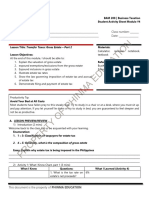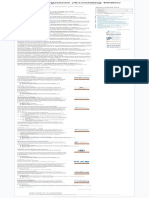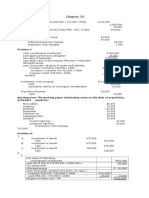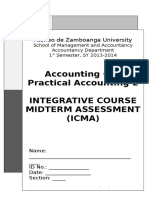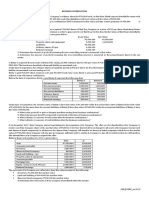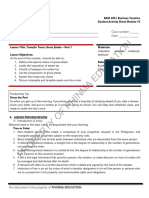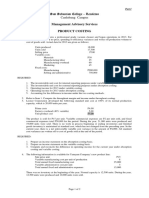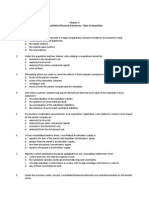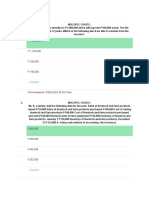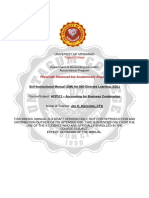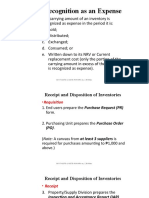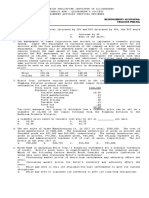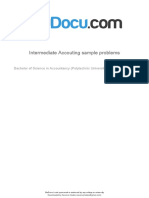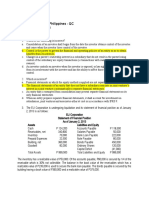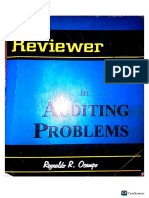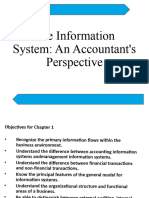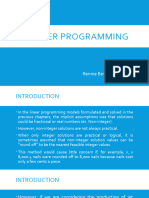0 ratings0% found this document useful (0 votes)
1K views17 pagesChapter 5 Problems
Uploaded by
Fel Salazar JapsCopyright
© © All Rights Reserved
We take content rights seriously. If you suspect this is your content, claim it here.
Available Formats
Download as PDF or read online on Scribd
0 ratings0% found this document useful (0 votes)
1K views17 pagesChapter 5 Problems
Uploaded by
Fel Salazar JapsCopyright
© © All Rights Reserved
We take content rights seriously. If you suspect this is your content, claim it here.
Available Formats
Download as PDF or read online on Scribd
You are on page 1/ 17
Chapter 5
ners
Intercompany sale of property, plant and equipment an
The unamortized deferred gain or loss is eliminated whe,
consolidated financial statements are prepared.
Intercompany dividend it ;
If the parent recognized the dividend as dividend income, the
dividend income is eliminated from the consolidated profit or loss,
Intercompany bond transaction ; ;
The bonds are considered extinguished. A gain or loss is recognized
in the consolidated financial statements.
PROBLEMS:
PROBLEM 1; MULTIPLE CHOICE - THEORY
1. Perez, Inc. owns 80% of Senior, Inc. During 1992, Perez sold
goods with a 40% gross profit to Senior. Senior sold all of
these goods in 1992, For 1992 consolidated financial
statements, how should the summation of Perez and Senior
income statement items be adjusted?
a. Sales and cost of goods sold should be reduced by the
intercompany sales.
b. Sales and cost of goods sold should be reduced by 80% 0!
the intercompany sales.
e
Net income should be reduced by 80% of the gross proft
on intercompany sales,
d. No adjustment is necessary.
(Adapted)
2. Water Co. owns 80% of the out:
Co. On December 31, 1989, Fis
Price in excess of
standing common stock of Fi
te sold equipment to Watet #?
Fire's carrying amount, but less tha?"
original cost. On a consolidated balance sheet at Decembe! iB
1989, the carrying amount of the (cost less accumula!
depreciation) equipment should be reported at:
a. Water's original cost.
yr
Consolidated Financial Statements (Part 2) 227
p. Fire's original cost.
c. Water's original cost less Fire's recorded gain.
d. Water's original cost less 80% of Fire's recorded gain.
(Adapted)
3, P Co. purchased term bonds at a premium on the open
market. These bonds represented 20 percent of the
outstanding class of bonds issued at a discount by S Co., P's
wholly owned subsidiary. P intends to hold the bonds until
maturity. In a consolidated balance sheet, the difference
between the bond carrying amounts in the two companies
would be:
a. Included as a decrease to the consolidated profit or loss
and retained earnings.
b. Included as an increase to the consolidated profit or loss
and retained earnings.
c. Reported as a deferred debit to be amortized over the
remaining life of the bonds.
d. Reported as a deferred credit to be amortized over the
remaining life of the bonds.
(Adapted)
4. In its financial statements, Pare, Inc. uses the fair value
method of accounting for its 15% ownership of Sabe Co. At
December 31, 1993, Pare has a receivable from Sabe. How
should the receivable be reported in Pare's December 31, 1993,
balance sheet?
a. The total receivable should be reported separately.
b. The total receivable should be included as part of the
investment in Sabe, without separate disclosure.
© Eighty-five percent of the receivable should be reported
separately, with the balance offset against
da. Sabe's payable to Pare.
© The total receivable should be offset against Sabe's payable
to Pare, without separate disclosure.
(Adapted)
Chapter 5
5, A 70%-owned subsidiary company declares and pays a cay,
; dividend. What effect does the dividend have on the retaingy
earnings and non-controlling interest balances in the paren,
company’s consolidated balance sheet?
a. No effect on either retained earnings or non-controlling
interest. ;
b. No effect on retained earnings and a decrease in non.
controlling interest.
c. Decreases in both retained earnings and non-controlling
interest,
d. A decrease in retained earnings and no effect on non-
controlling interest.
(Adapted)
6. Port, Inc. owns 100% of Salem Inc. On January 1, 1992, Port
sold Salem delivery equipment at a gain. Port had owned the
equipment for two years and used a five-year straight-line
depreciation rate with no residual value. Salem is using a
three-year straight-line depreciation rate with no residual
value for the equipment. In the consolidated income
statement, Salem's recorded depreciation expense on the
equipment for 1992 will be decreased by:
a. 20% of the gain on sale.
b. 33 1/3%.of the gain on sale.
©. 50% of the gain on sale,
d. 100% of the gain on sale,
(Adapted)
7. Sun Co. is a wholly owned
companies have separate Seneral ledgers, and prepa
“Beare financial statements. Sun, Tequires stand-alone
imancial statements. Which of 0 i s
— of the following statements
subsidiary of Star Co. Both
a. Consolidated financial s
both Star and Sun,
b. Consolidated financial statements should only ©
Prepared by Star and not by Sun.
tatements should be prepared by
yr
consi
ated Financial Statements (Part 2) 229
Atter consolidation, the accounts of both Star and Sun
should be changed to reflect the consolidated totals for
future ease in reporting,
After consolidation, the accounts of both Star and Sun
should be combined together into one general ledger
accounting system for future ease in reporting.
(Adapted)
Use the,
following information for the next three questions:
Basketball Co. wholly owns Volleyball Co, During the year,
Basketball purchased inventory from Volleyball. Volleyball has
marked-up the goods at 20% above cost.
8. How should the group compute for the consolidated sales?
a.
b.
Sales of Basketball plus sales of Volleyball
Sales of Basketball plus sales of Volleyball minus the
intercompany sale
Sales of Basketball plus sales of Volleyball plus the
intercompany sale
Sales of Basketball plus sales of Volleyball minus the
s profit from intercompany sale
unrealized gro
9. How should the group compute for the consolidated cost of
sal
a.
b.
les?
Cost of sales of Basketball plus cost of sales of Volleyball
Cost of sales of Basketball plus cost of sales of Volleyball
minus intercompany sales
Cost of sales of Basketball plus cost of sales of Volleyball
minus intercompany sales plus unrealized profit in ending
inventory and minus realized profit in beginning
inventory
Cost of sales of Basketball plus cost of
minus intercompany sales minus unreali:
ending inventory and plus realized profit
inventory
sales of Volleyball
zed profit in
in beginning
Y
230 Chapters |
ee as SO yd
10. How should the group compute for the consolidated ending
inventory?
a, Ending inventory of Basketball plus ending inventory of
Volleyball minus unrealized profit in ending inventory
b. Ending inventory of Basketball plus ending inventory g
Volleyball plus unrealized profit in ending inventory
c. Ending inventory of Basketball plus ending inventory of
Volleyball minus intercompany sales minus untealizeg
profit in ending inventory and plus realized profit in
beginning inventory
d. Ending inventory of Basketball plus ending inventory of
Volleyball minus intercompany sales plus unrealized
profit in ending inventory and minus realized profit in
beginning inventory
PROBLEM 2: FOR CLASSROOM DISCUSSION
Intercompany sale of inventory
1. Dream Co. owns 75% interest in Theater Co. The following
transactions occurred during the year:
a. Dream Co. sold goods costing P20,000 to Theater Co. for
P38,000. Theater Co, held P9,500 of these goods in its ending
inventory,
b. Theater Co. sold goods to Dream Co. for 40,000. The gros
Profit rate is 20% based on sale price. Dream Co. sold o*
fourth of the goods to unrelated parties during the year.
The individual statements of profit or loss of the entities du"
_the year show th following information:
0
1,000,000 700,000
000)
__ (400,000 350)
( ) ( 700
350,
The entities held the following inventories at year-end:
-
consolidated Financial Statements (Part 2) ‘ 21
E— Dream Co. __ Theater Co.
ew ee 800000
| On January 1, 20x1, Bright Co. acquired 75% interest in Dull
Co. for P180,000. On this date, the carrying amount of Dull’s
net identifiable assets was P160,000, equal to fair value. Non-
controlling interest was measured using the proportionate
share method.
The financial statements of the entities on December 31, 20x1
show the following information:
Bright Co. Dull Co.
ASSETS
Investment in subsidiary (at cost) 180,000 -
Equipment - net 400,000 190,000
Other assets 200,000
TOTAL ASSETS 780,000
LIABILITIES AND EQUITY
bilities 70,000 25,000
Share capital ce {00,000 100,000
Retained earnings 110,000 110,000,
otal equity 710,000 210,000
IOTAL LIABILITIES AND EQUITY 780,000 735,000
Bright Co. Dull Co.
Revenues 300,000 80,000
lati (12,000)
Preciation expense (40,000)
Other ees (32,000) (18,000)
===" 4
i Chapter 5
ee
12,000
Gain on sale of equipment -
Profit for the year 240,000 50,000
Additional information:
* No dividends were declared by either entity during 294
There is also no impairment of goodwill.
* However, on January 1, 20x, right after the business
combination, Bright Co. sold equipment with historical cost of
P 120,000 and accumulated depreciation of P72,000 to Dull Co,
for P60,000. Bright Co. has been depreciating this equipment
over a useful life of 10 years using the straight-line method,
Dull Co. decided to continue this accounting policy and |
depreciate the equipment over its remaining useful life of
years. |
Requirement:
a. What is the carrying amount of the equipment sold by Bright
Co. to Dull Co. in the consolidated financial statements?
- How much is the consolidated ‘Equipment net’?
How much is the consolidated ‘Depreciation expense’?
d. Prepare a draft of the December 31, 20x1 consolidated
Statements of financial position and consolidated statement of
profit or loss.
°
Intercompany dividends
3. Ice Co. owns 75% interest in Fire Co, On acquisition date, the
carrying amount of Fire Co.’s net identifiable assets ¥®
240,000; equal to fair value. Non-controlling interest ¥%
measured using the Proportionate share method,
In 20x1, Fire Co.
I declared 100,000 dividends. Selec?
information on the enti
ties on December 31, 20x1 is shown belo™’
. IceCo,> __ Fire C
Statement of financial position accounts:
Share capital 800,000 200,000
Retained earnings 280,000° 120,008
Total equity 7,080,000 320,004
Consolidated Financial Statements (Part 2) 233
Ice Co. Fire Co.
Statement of profit or loss accounts
Revenues 640,000 260,000
Expenses (240,000) (128,000)
Dividend income 75,000 -
Profit or loss 475,000 132,000
Requirements: Compute for the following:
a. Non-controlling interest in the net assets of the subsidiary as
of year-end.
b. Consolidated retained earnings at year-end
Consolidated profit for the year broken down into amounts
attributable to the owners of the parent and attributable to
non-controlling interests.
Intercompany bond transaction
4. On January 1, 20x1, Sing Co. acquired 75% interest in Dance
Co. On this date, Sing Co.’s net identifiable assets have a
carrying amount of P200,000, equal to fair value. Non-
controlling interest was measured using the proportionate
share method.
On December 31, 20x1, Dance, Inc. purchased all of the
outstanding bonds of Sing Co. from the open market for P250,000.
There were no other intercompany transactions during the year.
The year-end individual financial statements show the following
information:
Sing Co. Dance Co.
ASSETS
Investment in subsidiary (at cost) 180,000 :
Investment in bonds - 250,000
Other assets 500,000 50,000
TOTAL ASSETS 680,000 300,000
nl
UABILITIES AND EQUITY
Accounts payable 40,000 30,000
234 Chapter 5
wa
Total liabilities 340,000 30,009
Share capital 200,000 100,009
Retained earnings ~_ 140,000 170,000
Total equity 340,000 270,009
TOTAL LIABILITIES AND EQUITY 680,000 __ 300,000
Sing Co. Dance Co
300,000 120,000
Revenues
Operating expenses (217,000) (100,000)
Interest expense (3,000) -
Profit for the year 80,000 20,000
Requirements:
a. Compute for the gain (loss) on extinguishment of bonds to be
recognized in the 20x1 consolidated statement of profit or loss.
b. Compute for the consolidated total bonds payable.
¢. Prepare a draft of the 20x1 consolidated statement of financial
position and statement of profit or loss.
PROBLEM 3: EXERCISES
1, Orion Co. owns 75% interest in Sanitarium Co. The following
transactions occurred during the year:
a. Orion Co. sold goods costing P12,000 to Sanitarium C°
The goods were marked-up at 25% on selling pit
Sanitarium Co. held half of these goods in its endif
inventory.
Sanitarium Co. sold goods to Orion Co, for P60,000. T
goods were marked-up at 20% on cost. Orion Co. $4
three-fourths of the goods to unrelated parties during the
year.
The individual statements of profit or loss of the entities dul"?
the year show the following information;
ancial Statements (Part 2) 235
canslidated Fi
Orion Co. Sanitarium Co.
Sales 1,000,000 700,000
Cost of sales (400,000) (350,000)
ees pit 600,000 350,000
The entities held the following inventories at year-end:
Orion Co. Sanitarium Co.
Ending inventory 300,000 80,000
Requirements: Compute for the following:
a. Consolidated sales
b. Consolidated cost of sales
c. Consolidated ending inventory
2. On January 1, 20x1, Day Co. acquired 75% interest'in Night
Co. for P216,000. On this date, the carrying amount of Night’s
net identifiable assets was 192,000, equal to fair value. Non-
controlling interest was measured using the proportionate
share method.
The financial statements of the entities on December 31, 20x1
show the following information:
DayCo. ‘Night Co.
ASSETS
Investment in subsidiary (at cost) 216,000
Equipment - net 480,000 228,000
Other assets 240,000 54,000
TOTAL ASSETS 936,000 282,000,
aLOTALASSETS OE
LIABILITIES AND EQUITY
Liabilities 84,000 30,000
Share capital 720,000 120,000
Total equit 852,000. 252,000
ano eaiett ie em
TOTAL LIABILITIES AND EQUITY 936,000 282,000
236 Chapter 5
PRO
Day Co. Night Co,
Revenues 360,000 96,000
Depreciation expense (48,000) (14,400)
Other expenses (38,400) (21,600)
Gain on sale of equipment 14,400 -
Gain on sale of equipment
Profit for the year 288,000 60,000
Additional information:
* No dividends were declared by either entity during 20x.
There is also no impairment of goodwill.
* However, on January 1, 20x1, right after the business
combination, Day Co. sold equipment with historical cost of
144,000 and accumulated depreciation of P86,400 to Night
Co. for P72,000. Day Co. has been depreciating this equipment
over a useful life of 10 years using the straight-line method
Night Co. decided to continue this accounting policy and
depreciate the equipment over its remaining useful life of 4
years.
Requirement
a. What is the carrying amount of the equipment sold by Da¥
Co. to Night Co. in the consolidated financial statements?
How much is the consolidated ‘Equipment —net’?
How much is the consolidate
a
d ‘Depreciation expense’?
d. Prepare a draft of the December 31, 20x1 consolidate!
statements of financial position and consolidated statement “
profit or loss.
3. Loud Co. owns 75% interest in Soft Co. On acquisition 43"
the carrying amount of Soft Co.’s net identifiable assets “”
P240,000, equal to fair value. Non-controlling interest
measured using the proportionate share method.
In 20x1, Soft Co. declared 150,000 dividends, Sele”
information on the entities on December 31, 20x1 is shown bel™
os carats _ Loud Co, Soft Co.
Gatement of financ ial position accounts.
$
share capital . 1,200,000 300,000
Retained earning: ___ 420,000 180,000
000
Total equity.
al Statements (Part 2) 27
Loud Co. __ Soft Co.
Statement of profit or loss accounts
Revenues 960,000 200,000
Expenses (360,000) (192,000)
Dividend income 112,500 2
Profit or loss 712,500 198,000
Requirements: Compute for the following:
a. Non-controlling interest in the net assets of the subsidiary as
of year-end.
b. Consolidated retained earnings at year-end
«. Consolidated profit for the year broken down into amounts
attributable to the owners of the parent and attributable to
non-controlling interests.
4 On January 1, 20x1, Walk Co. acquired 75% interest in Run Co.
On this date, Sing Co.’s net identifiable assets have a carrying
amount of P208,000, equal to fair value. Non-controlling
interest was measured using the proportionate share method.
On December 31, 20x1, Dance, Inc. purchased all of the
outstanding bonds of Sing Co. from the open market for P320,000.
There were no other intercompany transactions during the year.
The year-end individual financial statements show the following
'nformation:
Walk Co. Run Co.
ASSETS
Investment in subsidiary (at cost) 234,000 :
'vestment in bonds a 320,000
her assets 650,000 64,000
TC
otissets 850,000
OTAL ASSETS 884,000 384,000
Chapter 5 |
(ee ee
UITY
LIABILITIES AND EQ! a tent
Accounts payable i 300,000 :
Bonds payable (at face amount .
000 150,000 >
Total liabilities = 7 ee |
Sharé capital , }
Retained earnings a - Saute
TOTAL LIABILITIES AND EQUITY ___ 884,000 384,000
Walk Co. Run Co,
Revenues 390,000 156,000
Operating expenses (282,100) (130,000)
Interest expense (3,000) :
Profit for the year 104,900 26,000
Requirements:
a, Compute for the gain (loss) on extinguishment of bonds tobe
recognized in the 20x1 consolidated statement of profit or loss.
b. Compute for the consolidated total bonds payable.
c. Prepare a draft of the 20x1 consolidated statement of financil
Position and statement of profit or loss.
PROBLEM 4: MULTIPLE CHOICE - COMPUTATIONAL
Use the following information ‘for the next tivo questions:
Selected information from the separate and consolidated balan
sheets and income statements of Pare, Inc. and its subsidiary, 9
Co, as of December 31, 1994, and for the year then ended
follows:
Pare Shet___consolids
Balance sheet accounts:
Accounts receivable 52,000 38,000 78,000
Inventory 60,000 50.000 104,000
Ge
Consolidated Financial Statements (Part 2) 239
Income statement accounts:
© Revenues 400,000 280,000 616,000
Cost of goods sold 300,000 _ 220,000 462,000
Gross profit 100,000 __ 60,000 154,000
Additional information:
During 1994, Pare sold goods to Shel at the same markup on cost
that Pare uses for all sales.
1. What was the amount of intercompany sales from Pare to Shel
during 1994?
a 6,000 ¢. 58,000
b. 12,000 d. 64,000
(Adapted)
2. In the consolidation worksheet, what amount of unrealized
intercompany profit was eliminated?
a. 6,000 cc. 58,000
b. 12,000 d. 64,000
(Adapted)
3. Parker Corp. owns 80% of Smith Inc.'s common stock. During
1991, Parker sold Smith 250,000 of inventory on the same
terms as sales made to third parties. Smith sold all of the
inventory purchased from Parker in 1991, The following
information pertains to Smith and Parker's sales for 1991:
Parker Smith
Sales 1,000,000 700,000
Cost of sales 400,000 350,000
Gross profit 600,000 350,000
What amount should Parker report as cost of sales in its 1991
| onsolidated income statement?
a. 750,000 . 500,000
b. 680,000 d. 430,000
(Adapted)
Chapter 5
240
~
4. Selected data for two subsidiaries of Dunn Corp. taken fog |
December 31, 1988 pre-closiny trial balances are as follows |
: Banks |
Lamm
Co. Co,
Debit Credit
; é 150,000 |
s to Banks ood
Shipments to Ban 200,000 oe
Shipments from Lamm
Intercompany inventory profit on total
a 50,000
shipments
Additional data relating to the December 31, 1988 inventory are as
follows: :
Banks Co. _ Lamm Co.
Inventory acquired from outside parties 175,000 250,000
Inventory acquired from Lamm 60,000 -
The inventory to be included in the December 31, 198
consolidated financial statements is:
a. P425,000 c. P470,000
b. P435,000 dl. P485,000
(Adapted) :
Use the following information for the next three questions:
On January 2
2, 1994, Pare Co. acquired 75% of Kidd ©
outstanding common stock. On the acquisition date, the boo
value of Kidd's assets and liabilities equaled their fair vali
Non-controlling interest was measured using the proportion
share method. Selected balance sheet data at December 31, 1994"
as follows:
idd
ha re
Total assets 720,000 730,000,
Liabilities 120,000 60,000
Common stock 100,000 50,000
Retained earnings ’ roo
E - 200,000 p
Total liabilities and equit ey
consolidated Financial Statements (Part 2) 241
During 1994, Pare and Kidd paid cash dividends of P25,000 and
5,000, respectively, to their shareholders. There were no other
intercompany transactions.
In the December 31, 1994 consolidated balance sheet, what
amount should be reported as non-controlling interest in net
assets?
a 0 c. 45,000
b. 30,000 d. 105,000
(Adapted)
6. In the December 31, 1994 consolidated balance sheet, what
amount should reported as common stock?
a. 50,000 ¢. 137,500
b. 100,000 d. 150,000
(Adapted)
7. In the December 31, 1994 consolidated statement of retained
earnings, what amount should be reported as dividends paid?
a. 5,000 c. 26,250
b. 25,000 d.. 30,000
(Adapted)
8. On January 1, 20X9, Paul Corporation acquired 80% of Saul
Corporation's 200,000 shares of the outstanding common stock
of for P5,000,000. Paul did not pay a control premium in the
acquisition. On the date of acquisition, the P6,000,000 book
value of Saul's net assets equaled fair value. Non-controlling
interest was measured at fair value. During 20X9, Saul
Teported net income of 550,000 and paid dividends of
165,000. What is the non-controlling interest that will be
teported on Paul Corporation's December 31, 20X9
Consolidated balance sheet?
a. 1,200,000 ©. 1,277,000
>. 1,250,000 d. 1,327,000
(Adaptegy
Chapter 5
Fane
2a
9, Clark Co. had the following transactions with affiliated partie,
during 1992: : -
Sales of P60,000 to Dean, Inc, with 20,000 gross profi,
Dean had P15,000 of inventory on hand at year-end. Clay,
owns a 15% interest in Dean and does not exert significant
influence.
© Purchases of raw materials totaling P240,000 from Kent
Corp., a wholly-owned subsidiary. Kent's gross profit on
the sale was P48,000. Clark had P60,000 of this inventory
remaining on December 31,1992.
Before eliminating entries, Clark had consolidated current assets
‘of P320,000. What amount should Clark report in its December 31,
1992, consolidated balance sheet for current assets?
a. 320,000 ¢. 308,000
b. 317,000 d. 303,000
(Adapted)
10. Wagner, a holder of a P1,000,000 Palmer, Inc. bond, collected
the interest due on March 31, 1992, and then sold the bond to
Seal, Inc. for P975,000. On that date, Palmer, a 75% owner of
Seal, had a P1,075,000 carrying amount for this bond. What
was the effect. of Seal's purchase of Palmer's bond on the
retained earings and non-controlling interest amounts
reported in Palmer's March 31, 1992, consolidated balan?
sheet?
Retained earnings Non-controlling ii
ling interest
a. P100,000 increase PO eee
b. 75,000 increase 25,000 increase
4 P25,000 increase
. 100,000 increase
(Adapted)
You might also like
- Chapter 17 Consolidated Fs Part 1 Afar Part 20% (1)Chapter 17 Consolidated Fs Part 1 Afar Part 223 pages
- Intercompany Sale of PPE Problem 2: Requirement: January 1, 20x4No ratings yetIntercompany Sale of PPE Problem 2: Requirement: January 1, 20x431 pages
- Advanced Accounting Vol 2 Guerrero and Peralta ManNo ratings yetAdvanced Accounting Vol 2 Guerrero and Peralta Man1 page
- I. 1. Acquisition Method: Non-Controlling Interest Consolidated StatementNo ratings yetI. 1. Acquisition Method: Non-Controlling Interest Consolidated Statement14 pages
- Mas by Cabrera Chapter 1 Management Accounting An OverviewNo ratings yetMas by Cabrera Chapter 1 Management Accounting An Overview18 pages
- AC 300 Activity - 04.11.2023 Groupings: Group 1 Group 2 Group 3 Group 4 Group 5 Group 6No ratings yetAC 300 Activity - 04.11.2023 Groupings: Group 1 Group 2 Group 3 Group 4 Group 5 Group 62 pages
- Manila Cavite Laguna Cebu Cagayan de Oro DavaoNo ratings yetManila Cavite Laguna Cebu Cagayan de Oro Davao6 pages
- Acctg630 - ICMA 1st Sem SY2013-14 - With AnswerNo ratings yetAcctg630 - ICMA 1st Sem SY2013-14 - With Answer35 pages
- Accounting On Business Combination Quiz 2: Multiple ChoiceNo ratings yetAccounting On Business Combination Quiz 2: Multiple Choice13 pages
- Um Digos College Department of Accounting Education Acp 312 - First ExamNo ratings yetUm Digos College Department of Accounting Education Acp 312 - First Exam2 pages
- Transfer and Business Taxation Final Exam - CoasdsadNo ratings yetTransfer and Business Taxation Final Exam - Coasdsad16 pages
- Installment Sales & Repossession AnalysisNo ratings yetInstallment Sales & Repossession Analysis3 pages
- Business Com - Intercompany TransactionsNo ratings yetBusiness Com - Intercompany Transactions6 pages
- Success of Microfinance Institutions: The Ghanaian ExperienceNo ratings yetSuccess of Microfinance Institutions: The Ghanaian Experience7 pages
- The Effect of Loan Appraisal Process ManNo ratings yetThe Effect of Loan Appraisal Process Man7 pages
- Topic 2 Transportation Transshipment and AssignmentNo ratings yetTopic 2 Transportation Transshipment and Assignment29 pages






